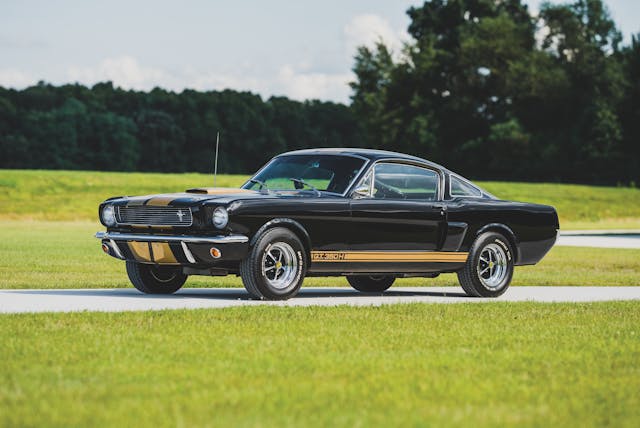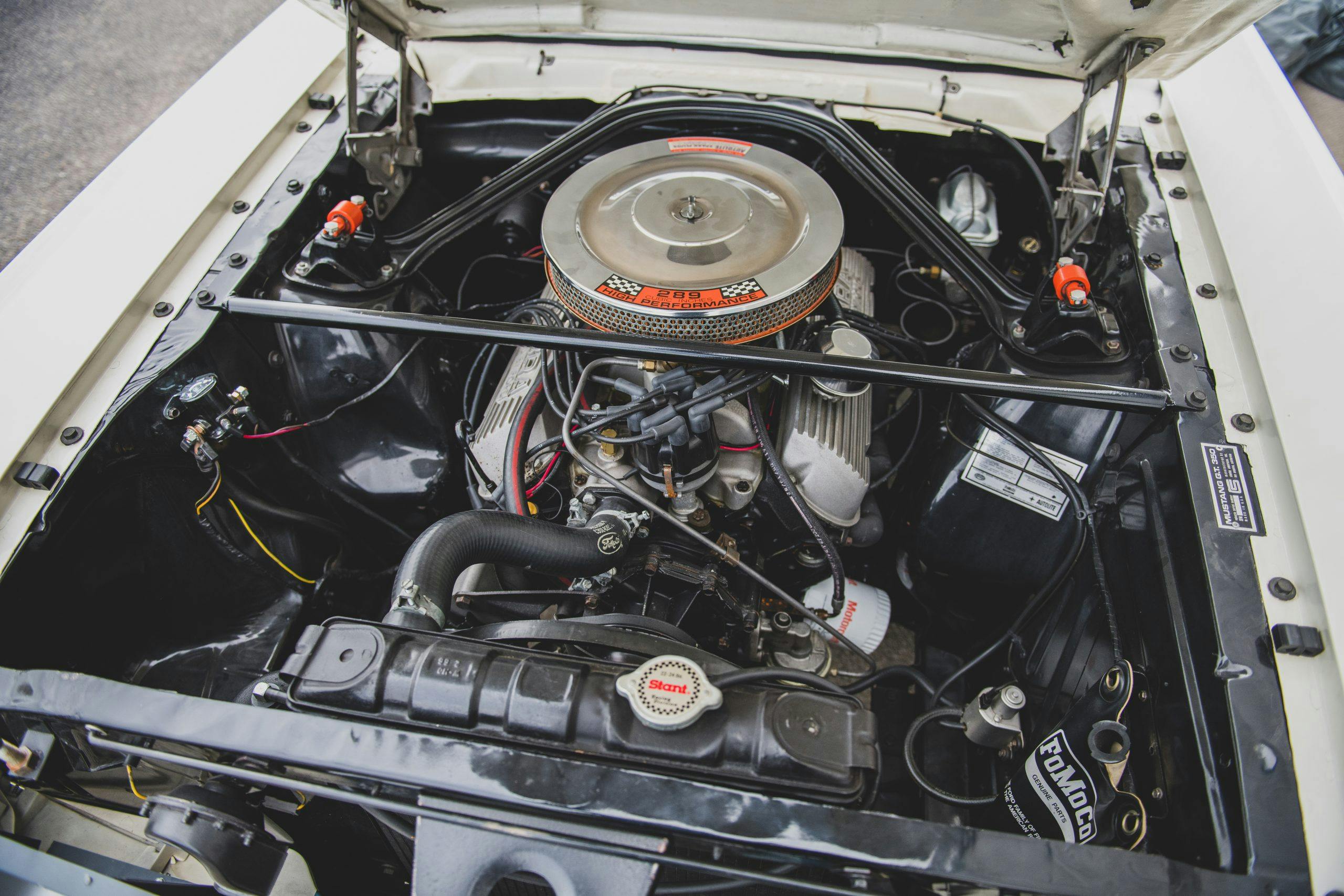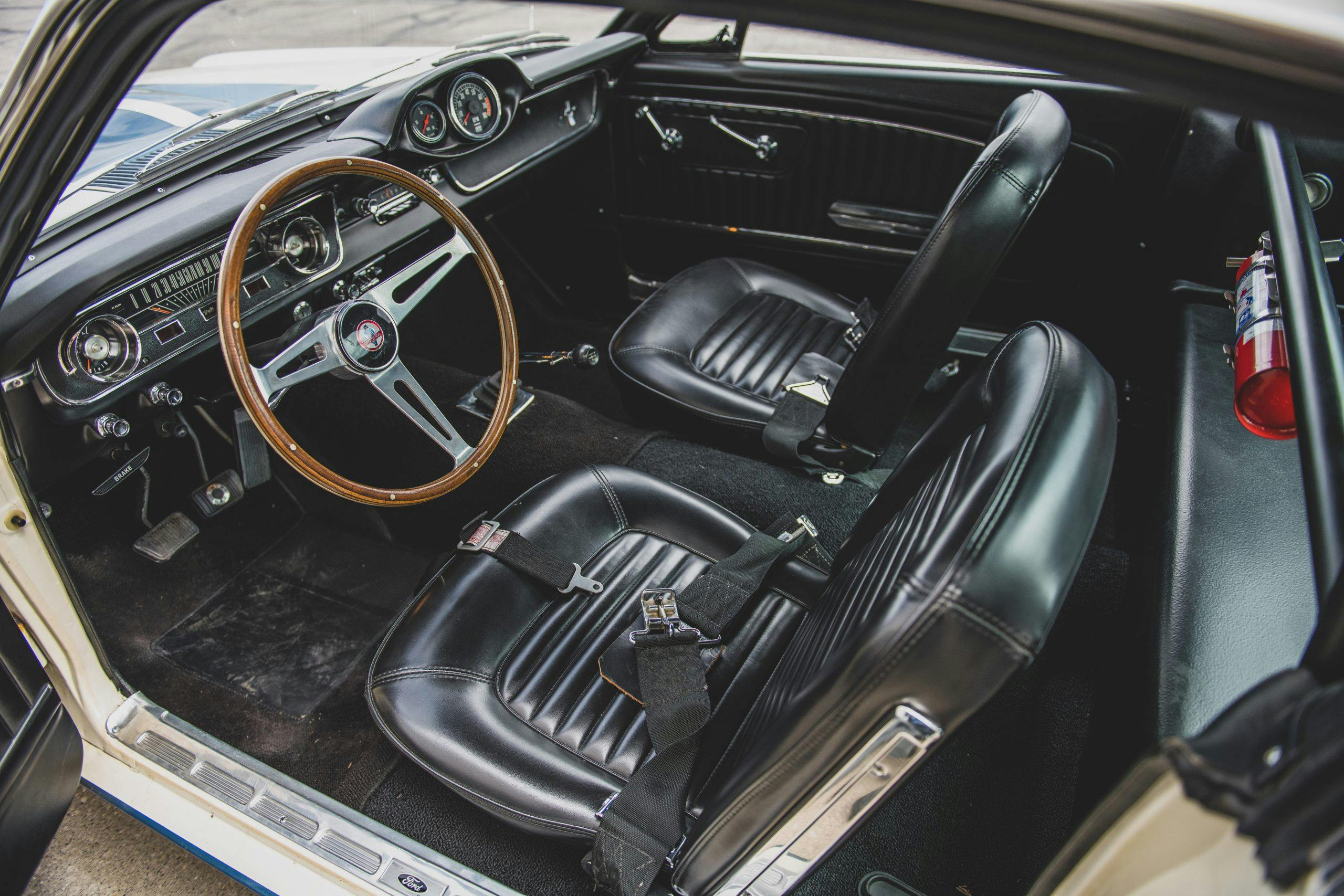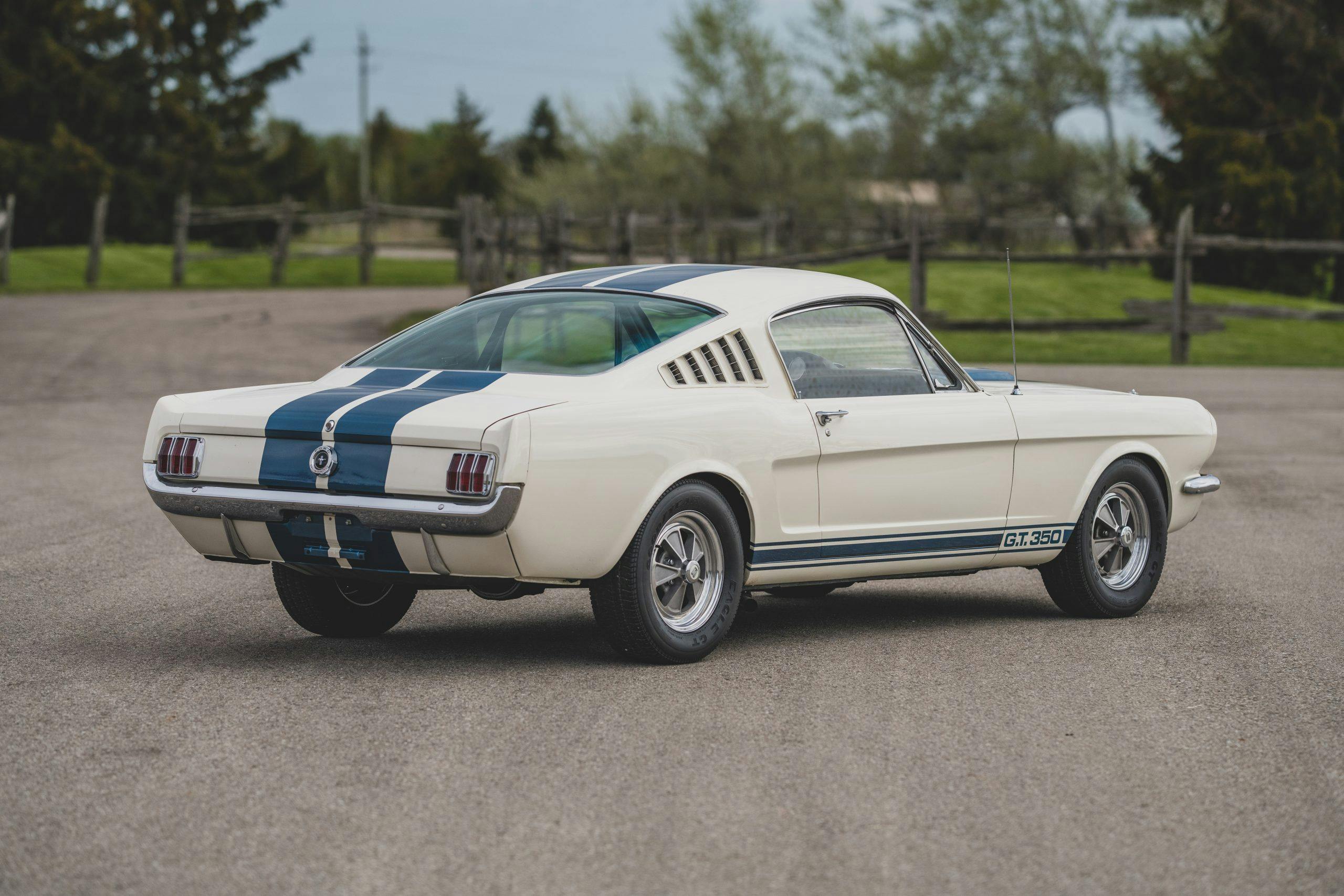Your handy 1965-66 Shelby GT350 buyer’s guide
Let’s face it: No matter where you live or who you are, there’s a good chance the 1965–66 Shelby GT350 is the brightest star in a milky way of Ford Mustang performance. It’s an icon, and it’s the first of a series of Mustangs tuned by Carroll Shelby with performance that received critical acclaim and endless enthusiasm from enthusiasts. So let’s dig into what made the Shelby GT350 the automotive icon it is today.
1965
No discussion of the GT350 is complete without a deeper dive into the original Ford Mustang on which it was based. The full year of 1965 Mustang production introduced the fastback body style, was priced between the affordable hardtop and convertible, and sported a wildly sloped roofline with unique rear glass and decklid. The end result, especially when equipped with Ford’s K-code small block V-8, gave the Mustang a more performance-oriented feel compared to a run-of-the-mill example. But it still didn’t fit into Ford’s “Total Performance” marketing campaign, which highlighted how the company’s products benefitted from motorsports competition.
While a victory at the 1964 Tour de France was admirable, the Mustang needed a stateside motorsports connection to better establish the necessary bonafides. The powers that be decided on the SCCA B/Production class, as that’s where small-block-powered Corvettes were racing. Ford (via Ray Geddes, Ford’s GT and Sports Car Manager) initially attempted to make inroads with the SCCA that didn’t go so well, mostly because Ford failed to address the B/Production class guideline that only two-seater vehicles were eligible for consideration. So it was only natural that Ford tapped Carroll Shelby, who already had a good reputation thanks to the Ford V-8 powered Cobra, to turn the Mustang pony car into a proper sports car. The end result was an intelligently modified version of the K-code Mustang fastback.
Shelby boosted the GT350’s power output after replacing the K-code’s Autolite 4100 carburetor for a 715-cfm Holley, exchanging the exhaust manifolds for TRI-Y tube headers, and adding an aluminum dual plane intake plus a side-exit exhaust with glasspack mufflers. The end result was a reported 306 hp (35-hp increase) at 6000 rpm and 329 lb-ft (a 17-hp increase) of torque. The car was kept slippery and cool by a Shelby designed, aluminum-finned, T-shaped oil pan with a higher oil capacity that kept the GT350 free from oil starvation when taking corners at high speed. The K-code’s Toploader four-speed was replaced with a special aluminum cased Borg Warner T-10M gearbox with close ratio gears. Weight was also a consideration in relocating the battery to the rear, but a mid-cycle update moved the battery back up front due to venting concerns as well as cost savings.
Front brakes were stock K-code Mustang Kelsey-Hayes discs while the rear brakes were improved thanks to the larger, 2 1/2-inch wide drums from the Ford Galaxie with aggressive sintered metallic brake shoes, fed by a Kelsey-Hayes adjustable proportioning valve. “Override” traction bars by Traction Master, Koni shocks, droop limiting cables, and a Detroit locker differential within the factory 3.89:1 geared 9-inch rear axle beefed up the Shelby’s hind quarters. Up front, Ford engineer Klaus Arning’s brilliant idea to drop the upper control arm’s mounting points by 1-inch (now called the “Arning Drop”) literally transformed the Mustang’s front suspension geometry and aided camber gain through turns. The GT350 also cornered with more precision thanks to a larger front sway bar (from 0.84-inches to 1-inch) and matching, adjustable Koni dampers. The standard steel wheel was a heavy-duty Kelsey-Hayes 15 x 6-inch wheel used on Ford station wagons and police cars, while the optional 15 x 6-inch Shelby/Cragar cast aluminum wheels reduced unsprung weight and added some bling to the package. No matter the wheel choice, all 1965 GT350s wore a special Goodyear’s Blue Dot 775-15 tire which were good for 130 mph.

A fiberglass hood sporting quick release hood pins and a functional hood scoop was added for weight savings. While these were originally all fiberglass, warpage issues meant a steel framed version came into play on later GT350s. A unique grille treatment with off center running Mustang emblem replaced the thicker “horse in a corral” design of regular Mustangs, and a modest “G.T. 350″ emblem adorned the rear. All 526 units of the 1965 GT350 were finished in Wimbledon White with the aforementioned Guardsman Blue rocker panel stripes. Guardsman Blue LeMans stripes on the hood/roof/trunk were optional, and those not equipped from Shelby often had them added at the Ford dealership before final sale to a customer, or by owners who found them more appealing than large swaths of white paint.
While 1965 Mustang comfort options like A/C, radio, and interior upgrades were off limits, Shelbys had a center dash gauge binnacle with a tachometer and oil pressure gauge, Ray Brown seatbelts, and a unique wood-rimmed, polished aluminum three-spoke steering wheel. The latter was originally lifted from the Shelby Cobra parts bin, and measuring 16 inches in diameter. This was reduced to a bespoke GT350 wheel measuring 15-inches for better ergonomics, but neither came with a horn button provision. The horn was subsequently relocated to the dashboard via momentary switch, while GT350s met SCCA’s guidelines by deleting the rear seat in favor of a fiberglass tray that converted the rear area into a flat floor.

But there was more to the GT350’s racing pedigree, as 36 examples turned into the race-only GT350 Competition, or GT350-R. The Competition models had approximately 350 horsepower thanks to a blueprinted long block, ported and polished heads and a port matched intake added to Ford’s K-code engine. Other performance upgrades included an oil cooler, up sized radiator, cooling ducts for front and rear brakes, 34-gallon fuel cell with electric fuel pump, racing exhaust with no mufflers and 15 x 7-inch American Racing Torq-Thrust wheels. External modifications to the GT350 Competition included a fiberglass lower front valence, larger wheel arches, plexiglass rear and side windows. Interior changes were similarly functional: tubular roll bar, optional racing bucket seats, revised instrumentation (including a fuel pressure gauge), and the deletion of all unnecessary luxury trappings like carpet and door panels.
1966
No longer including the Mustang in its name, the 1966 Shelby GT350 now added Raven Black, Candy Apple Red, Ivy Green Metallic, and Sapphire Blue Metallic to the paint palette. Production spiked to 1377 units with help from the new colors, a high-performance C4 automatic transmission (optional), and a Paxton supercharger. The supercharger was a special-order option, stemming from a meeting in 1965 when Joe Granatelli (from Studebaker’s Paxton Products Division) convinced Carroll Shelby of its value after famously beating Shelby’s 289 Cobra with a Paxton supercharged Shelby GT350 in a drag race. The GT350 now included bespoke quarter windows to replace the conventional Mustang fastback’s vent assemblies, functional quarter panel scoops for brake cooling, and the inclusion of a fold down rear seat (borrowed from the production Mustang).

The first 252 1966 GT350s are known as “Carry-over” or “Left over” cars as they are 1965 chassis built into 1966 model year cars by Shelby, and as a result, a unique blend of 1965 and 1966 features. Today these carry over cars are the most desirable 1966 production GT350s and have a devout following.
As production went on and Shelby grew into a proper manufacturer, many running changes resulted. Gone was the extremely loud side-exiting exhaust of the rambunctious 1965, replaced with the standard Mustang K-code exhaust system. The time-consuming and costly “Override” traction bars were replaced by “Underride” ones, the Detroit locker fell to Shelby’s options list, various hoods (including a steel version) were used, the expensive wood steering wheel and aluminum hub used on the 1965 cars was replaced with the standard Mustang “Deluxe” plastic wood wheel, and 14-inch wheels were standard equipment. Of the latter, there were four versions available: a standard steel wheel (borrowed from Chrysler), optional painted or chromed Magnum 500 wheels, or the optional cast aluminum “Ten spoke” alloy wheel.

The big news this year came from a stroke of marketing genius and the letter “H”. Hertz Rent a Car worked with parent company Ford to purchase 1001 GT350s to become GT350-H rental cars. Most were finished in Raven Black with gold stripes, and the GT350-H was famously promoted as a “Rent a Racer” for members of Hertz’s Sports Car Club. Those in the club could rent a GT350-H for the modest price of $17 per day and 17 cents per mile. Only the first 85 units owned by Hertz had the manual transmission, as GT350-Hs were often returned in need of significant reconditioning and evidence of roll cage installation for SCCA events.
A total of 2378 Shelby GT350s were sold this year, including four prototype convertibles used for testing future roofless Shelby vehicles.
Before you buy
Due to the rarity and demand of GT350s, verifying their authenticity is paramount to ensure you aren’t buying an unauthorized replica. Working with the Shelby American Automobile Club and referencing their registry should be your first step, and they can also confirm the GT350 in question’s confidential ford VIN matches the Shelby VIN, if you provide both to the registrar. Furthermore, other basics include determining if the Ford VIN on the engine block matches the chassis, if the Borg Warner T-10M is present and aluminum (not cast iron), and how much of the sheetmetal and Shelby parts are original. Some of these are tricky as many cars and parts have been doctored up to look original but are not. When in doubt, consult with an expert well versed in 1965 and 1966 GT350s.

Like all Mustangs of this era, the unitized chassis is prone to rust. Look for rust in the floor boards, shock towers, frame rails, the bottoms of the doors/trunk lid, around the windshield and rear window, and under the battery. While replacement sheetmetal is available, rust repair can be suspect. Be weary of poorly repaired areas that use fiberglass patch panels or copious amounts of body filler. Confirming that the doors close nicely is a good start, but remember that a genuine GT350 is valuable in any condition and there aren’t many out there, so restoring a genuine example to your standards is always something to consider.

After the metalwork, check the condition of the usual used car items—the powertrain, the trim, and the consumables. Just remember that correcting these items on a GT350 with good bones is relatively inexpensive and shouldn’t be a deal breaker. Most of the standard Mustang parts are readily available, and should be factored into the asking price of all GT350s except for all original examples in show-worthy condition. Factory original and NOS Shelby parts, however, are rarer than hen’s teeth, so plan to search hard and open your wallet to get everything you need for a true concours-quality example.
Combining the tips above with a test drive and a test of all features (lights, gauges, wipers, etc.) shall yield an accurate assessment of how much the GT350 is worth. When in doubt, again, hire a professional familiar with these unique cars to give you a full report: Given the potential value of a genuine example, their inspection cost is merely a drop in the bucket.
Valuation

Hagerty has longstanding insight into 1965–66 GT350 values but please check here for the latest values. One important note from our Hagerty Price Guide for GT350s to always consider is that “individual history and originality of chassis, body, and components dictate value more than condition.”
While GT350s dipped in values after 2008, they have now exceeded their pre-recession values. Examples in #2 (Excellent) condition are up 33 percent over the past 5 years for a normal 1965 GT350, up 45 percent for a supercharged example, but down 5 percent for a GT350-R.
As Hagerty’s own Colin Comer said, “cars need a performance image to worm their way into our brains, and to make us love them.” There’s no doubt that Ford and Carroll Shelby accomplished just that with the first Mustang to bear the Shelby moniker. If you are fortunate enough to find an honest-to-goodness, 1965–66 GT350 for sale, you won’t regret taking the opportunity to own this pivotal moment in pony car history.





